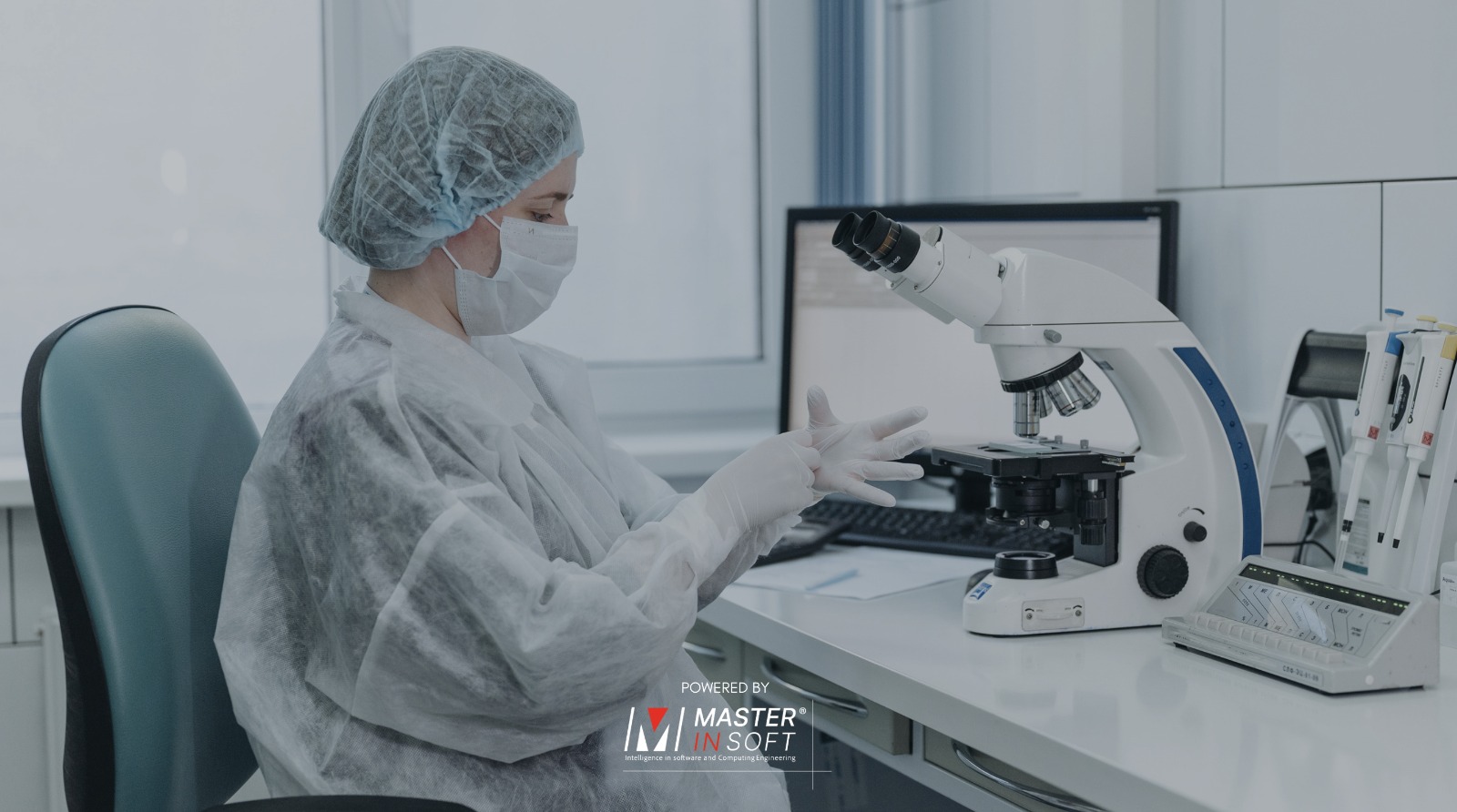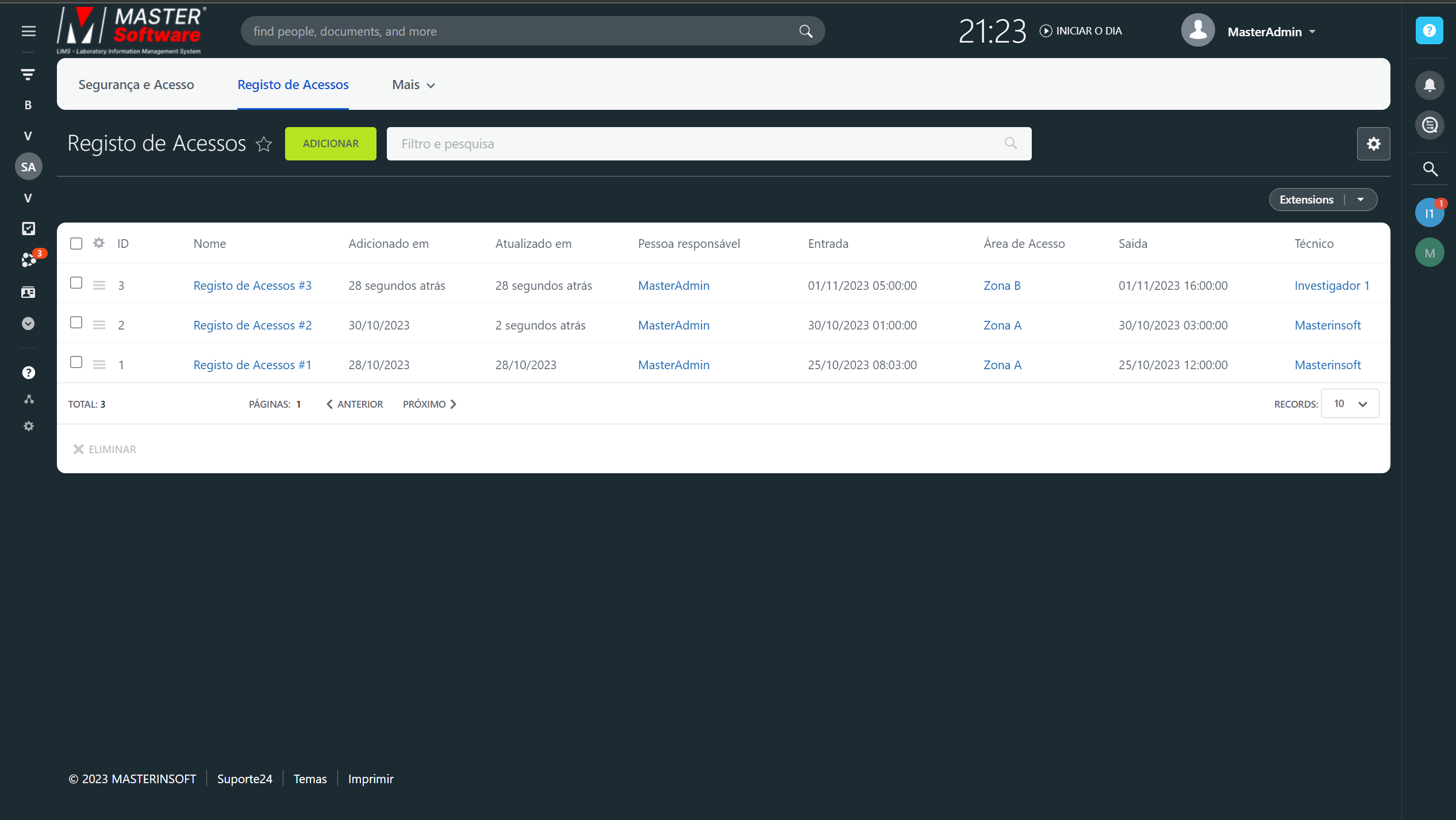MASTERINSOFT has everything you need to digitize and automate the management processes of an animal facility, ensuring agility, precision, and transparency. Our team’s expertise simplifies operations between the animal facility and researchers, optimizing connectivity between stakeholders and, above all, enhancing decision-making through intelligent platforms.
With MASTERINSOFT, you will receive full support from specialized consultants who provide advisory services, business process consultancy, technical and integration services, and the design of analytical information structures.
Project Authorization Process
Centralization and Digitization of the Process
- Request for Project Authorization:
Digitization of the Authorization Request Form, properly filled out. - Creation of a Working Group between Researchers and the Animal Facility to obtain a non-binding opinion (point 2, Article 43, of Decree-Law No. 113/2013) issued by ORBEA – Animal Welfare Body.
- File Management:
Non-technical Project Summary Template, Payment Guide, Proof of Payment of the “fee,” in accordance with, portuguese law, Ordinance No. 278/2022, dated 15/11/2022.
All in one place with a record of all operational histories.


Animal Management
Breeders.
The procedures for caring for breeders (males and females) when not in mating season are fundamental to ensure the health and well-being of the animals, as well as to maintain the quality of the lineage. Here are some general guidelines for handling breeders outside of the mating period:
Learn more...
- Housing:
- Provide appropriate cages in size and design that allow for a stable and comfortable environment for the breeders.
- Avoid overcrowding, ensuring enough space for the animal to move freely.
- Environment:
- Maintain temperature and humidity within the ideal parameters for the species.
- Ensure proper lighting, respecting the natural light/dark cycle.
- Control noise and vibration levels to prevent stress.
- Feeding:
- Provide a balanced and species-appropriate diet based on the animal’s life stage. The diet may vary according to the animal’s needs, such as reproductive condition.
- Ensure constant access to clean and fresh water.
- Health and Well-being:
- Conduct regular health checks to identify any potential health issues.
- Monitor for signs of stress or abnormal behavior.
- Avoid excessive handling of breeders to minimize stress.
- Environmental Enrichment:
- Provide physical and mental stimuli to prevent boredom and promote well-being.
- Offer toys, nesting materials, and structures for climbing or hiding, depending on the species.
- Socialization:
- Depending on the species and individual temperament, some breeders can be housed with others of the same species to promote socialization.
- However, constant monitoring is essential to avoid fights or competition.
- Record and Monitoring:
- Keep detailed records of the breeders’ health, behavior, and any social interactions.
- Regularly observe the animal’s physical condition, such as weight and coat, to detect any changes.
- Handling and Training:
- If necessary, train breeders to facilitate handling using positive reinforcement techniques.
- Limit handling only when necessary to reduce stress.
- Rest Between Breeding Cycles:
- Allow an adequate resting period between breeding cycles to prevent exhaustion and ensure the animal’s reproductive health.
- Preparation for the Next Mating:
- Depending on the species, it may be beneficial to perform specific health checks or preparations before returning to the breeding cycle.
Stock Management
Control the stock of food, medications, and other necessary materials, with alerts for replenishment.
Stock management is vital to ensure that an animal facility, or any establishment that cares for animals, consistently has the essential resources for the well-being and health of the animals. Let’s take a detailed look at how this management can be carried out, with an emphasis on food, medications, and other materials:

Learn more...
- Initial Inventory:
- Carry out a detailed survey of all items in stock.
- Classify items (e.g., food varieties, medications, equipment, etc.).
- Electronic Record:
- Adopt an electronic system to track the existing stock. Specialized software can help monitor consumption and identify when replenishment is needed.
- The system should allow adding details such as expiration dates, suppliers, costs, among others.
- Daily Use:
- Track and record the daily use of each product. For example, how much food is administered daily for each species of animal?
- This information will guide in anticipating when a product will run out.
- Stock Replenishment Notifications:
- Set up automatic notifications (e.g., email or SMS alerts) to trigger when a product reaches a pre-defined minimum level.
- These notifications can vary depending on the relevance of the product. A vital medication may trigger an earlier alert than a less critical item.
- Expiration Supervision:
- Monitor expiration dates of perishable products, especially medications and certain foods.
- The software should send notifications about products approaching their expiration date.
- Supplier Report:
- Keep a record of suppliers, including contact details, past orders, costs, delivery times, and product quality.
- This facilitates reordering and can enhance negotiations on prices or delivery terms.
- Consumption Evaluation:
- Use the data collected to assess consumption patterns, anticipate needs, and adjust orders accordingly.
- Storage Space:
- Ensure sufficient space to store products, particularly those requiring specific conditions, such as refrigeration.
- Organize the space in an orderly manner, providing easy access to the most frequently consumed products.
- Entry Procedures:
- Define a protocol for receiving new products: order confirmation, expiration date verification, proper storage, and updating the stock system.
- Stock Protection:
- Ensure that storage areas are secure, preventing theft or contamination.
- Medications and other sensitive products may require sealed packaging.
- Periodic Inspections:
- Perform regular inspections of stock, comparing the physical stock with the electronic record to ensure accuracy.
- Team Training:
- Ensure that all staff members are trained to operate the stock management system and understand the importance of maintaining accurate records.
With effective stock management, it ensures that animals always receive the necessary care, reducing waste and optimizing operations.
Software para gestão de Biotérios

Breeding Management and DNA Configurations
Breeding management, litters, and their respective birth dates, along with DNA structures.;.
The management of breeding, litters, and related data, such as birth dates and DNA configurations, is vital for animal facilities, particularly those involved in genetic research and breeding. A thorough record of this information provides an in-depth understanding of genetic lines, enhances animal health, and ensures that breeding and research objectives are met. Let’s break down each point:
Learn more...
- Breeding Management:
- Pair Records: Record which animals form pairs, including distinct identifiers (such as numbers or barcodes) for tracking.
- Breeding History: Keep a record of all breeding attempts, whether successful or not. This includes information on dates and relevant observations.
- Gestation Duration: Record the expected gestation period for each species or lineage and set up alerts for intensified observation when the birth is imminent.
- Litter Management:
- Litter Records: Upon the birth of the litter, document the number of offspring, their sex, weight, and other pertinent metrics.
- Litter Health: Monitor and document the health of the offspring, noting any abnormalities, necessary treatments, or mortality cases.
- Offspring Identification: Ensure each offspring in the litter has a unique identification, which may be through barcodes, tags, microchips, or other identification methods.
- Birth Dates:
- Detailed Records: In addition to the exact birth date, maintain detailed records about the birth circumstances, such as maternal health, complications during delivery, and other notes.
- Development Monitoring: Track significant developmental milestones of the offspring, such as eye opening, dental development, weaning, etc., depending on the species.
- DNA Configurations:
- Sample Collection: Define protocols for the careful and efficient collection of DNA samples, whether through blood, tissue, or other appropriate methods.
- Sample Preservation: Ensure DNA samples are properly preserved in environments that prevent degradation.
- Genetic Analysis: If genetic analysis is performed in-house, maintain detailed records of each test, including methods used, results, and interpretations. If samples are sent to external laboratories, document the details of the shipment and the results obtained.
- Genetic Database: Establish a robust database to store the genetic information of each animal, facilitating comparative analysis, lineage identification, and tracking of genetic inheritance.
In all of the above points, digitalization and automation can play a key role. Using specialized management software can simplify data entry, reduce errors, enable more efficient analysis, and provide a comprehensive perspective on genetics and breeding in the animal facility.
Software for Animal Facility Management

Environmental Record
Access to the facilities.
The procedures for caring for breeders (males and females) when they are not in breeding are essential to ensure the health and well-being of the animals, as well as to maintain the quality of the lineage. Here are some general guidelines for handling breeders outside of the breeding period:
Learn more...
Monitoring the environment in an animal facility is essential to ensure that the animals remain in optimal conditions for their well-being and the validity of experiments. Here are some relevant fields to consider when recording information about the environment in the facility:
- Date and Time:
- Each entry should include the date and time to identify when the measurement took place.
- Temperature:
- Record the ambient temperature, preferably in degrees Celsius.
- Relative Humidity:
- The percentage of humidity present in the air.
- CO2 Levels: T
- he amount of carbon dioxide present in the air, which is crucial for certain species.
- Ammonia Levels:
- Very important in spaces with rodents, as high levels can be harmful.
- Light Cycle: Infor
- mation about the light and dark cycle (e.g., 12 hours light/12 hours dark), including light intensity.
- Noise Levels:
- Measurement of decibels at the location, as excessive noise can cause stress to animals.
- Ventilation: Da
- ta on air circulation and the frequency of air changes in the space.
- Air Pressure: I
- n certain advanced facilities, air pressure is regulated to prevent contamination.
- Air Quality:
- Details about any potential contaminants or allergens in the air.
- Type of Housing:
- Information about the type of cage or housing (e.g., isolated cages, group cages, etc.).
- Cleaning and Disinfection:
- Date and method of cleaning or disinfecting the space.
- Monitoring Equipment:
- Information about the devices used to monitor the environment, including their calibration.
- Additional Observations:
- Any relevant notes about the environment or unusual circumstances.
The systematic collection of this data, combined with an alert system for situations outside of the desired standards, helps maintain the facility’s environment in optimal conditions. It is also crucial to update and modify these standards as new data or regulations arise.
Software for Animal Facility Management

Security and Access
Define access levels for different users, ensuring that only authorized personnel can perform certain operations.
Security and access control are essential in an animal facility or any animal care facility, especially concerning software and digital records. Defining access levels ensures that sensitive information and vital operations remain protected, accessible only to authorized personnel. Let’s break down how to implement this in detail:
Learn more...
- User Categories:
- Administrator: Has full access to all system functionalities, including user management, configurations, and backups.
- Animal Facility Manager: Can access and modify animal information, stock management, appointments, and other operational aspects. However, may not have full access to system configurations or user management.
- Technician/Veterinarian: Accesses animal health records, treatments, and procedures. May add information but typically cannot delete it.
- Maintenance Staff: Restricted access to specific areas, such as equipment management, cleaning, and maintenance.
- Visitor/Intern: Limited access, mainly for observation or entering basic data under supervision.
- Validation:
- Implement a secure login system with a combination of a username and a strong password. It would be ideal to add two-factor authentication for higher access levels.
- Audit and Logs:
- The software should automatically log all user actions, producing a history of activities, indicating who did what and when. This helps with accountability and resolving potential issues.
- Detailed Permissions:
- In addition to access levels, it is essential to have the ability to set detailed permissions. For example, a technician may be able to view animal health records but not modify system settings.
- Physical Access Control:
- Implement entry cards or biometric systems to regulate physical access to specific areas of the facility. This ensures that only authorized personnel can enter sensitive zones.
- Updates and Maintenance:
- Ensure that the software is regularly updated to protect against security vulnerabilities. Apply patches and updates routinely.
- Backup and Restoration:
- Set up frequent backup routines for all information to ensure data can be restored in case of system failure or security incidents.
- Training and Awareness:
- Train all users on the importance of security, proper practices for operating the system, and how to maintain confidentiality of information.
- Restricted Access to Sensitive Information:
- Data such as genetic information, clinical records, or research data may be particularly sensitive and should have even more restricted access.
- Automatic Logout:
- In shared computer terminals, set up automatic logout after a period of inactivity to prevent unauthorized access.
- Secure Communication:
- If the software has communication or data transfer features, ensure it uses secure protocols, such as SSL/TLS.
- Security Policy:
- Establish a clear security policy for all users, outlining responsibilities, procedures, and protocols to be followed.
- By implementing these practices and access structures, an animal facility can ensure the protection of its data and operations, safeguarding both animal welfare and the integrity of research and daily tasks.
Software for Animal Facility Management
Alerts and Automation
Automation of all communications.
At MASTERINSOFT, we recognize the importance of configuring alerts and automations according to the specific needs of a project to ensure efficiency and accuracy in any management system, especially in environments as detailed as animal facilities. Let’s explain how this can be implemented:

Learn more...
At MASTERINSOFT, we recognize the importance of configuring alerts and automations according to the specific needs of a project to ensure effectiveness and accuracy in any management system, particularly in environments as detailed as animal facilities. Let’s explain how this can be implemented:
Alert Configuration:
Objective: Inform users about events, conditions, or relevant milestones.
- Time-Based Alerts:
- Example: If a species has a 30-day gestation period, we set an alert to notify caretakers 2 days before the estimated birth date.
- Condition-Based Alerts:
- Example: If the number of animals in a cage exceeds the capacity, an alert is triggered.
- Restocking Alerts:
- Example: When stock levels of food or medication reach a critical point, an alert is generated to request restocking.
Configurable Automations:
Objective: Simplify recurring tasks or processes based on established conditions to enhance efficiency.
- Automated Data Entry:
- Example: If an animal is weighed on a connected scale, its weight is automatically recorded in the animal’s profile in the system.
- Condition-Based Automation:
- Example: If an animal shows certain symptoms, the system automatically schedules a veterinary appointment or suggests a series of tests.
- Time-Based Automations:
- Example: Schedule routine tasks like cleaning or feeding to be automatically logged in the system at defined intervals.
Adjustable Configuration Based on the Project:
- Customizable Parameters: Depending on the project or research being conducted, users can set their own criteria for alerts and automations.
- Templates and Workflows: We enable users to create and save templates for routine processes, allowing them to adjust them as needed for different initiatives.
- Integration with Other Systems: Depending on the complexity and requirements, MASTERINSOFT can be integrated with other systems, such as laboratory devices or infrastructure management systems. Automation helps consolidate data across these systems.
Feedback and Adjustments:
Logs and History: MASTERINSOFT maintains detailed documentation of all sent alerts and automated actions for future review and analysis.
User Feedback: We encourage users to share feedback on the relevance and accuracy of alerts and automations, enabling continuous adjustments and improvements.
In conclusion, flexibility and adaptability are key to the effectiveness of alerts and automations. Each project in an animal facility will present distinct challenges and needs. The ability to tailor alerts and automations to these demands ensures that MASTERINSOFT remains a valuable and productive tool.
Software for Animal Facility Management
PRICE
Certainly, we will meet your needs.
Our software is composed of various modules, and these modules will determine the total price. To provide you with the most accurate proposal, we need to assess your needs.
Please let us know when we can contact you so we can analyze what you truly require.

I would like to be contacted.
Let us know when, and we will contact you.
Intelligent online management software
Online bookings, resource and space management, automated communication via email, SMS, or voice messages, financial management, and invoicing.

